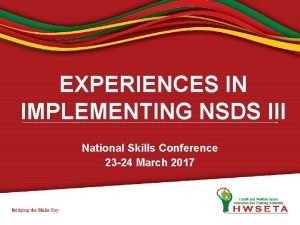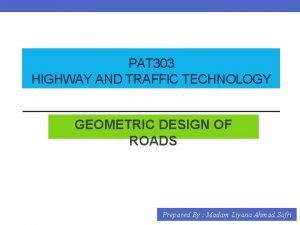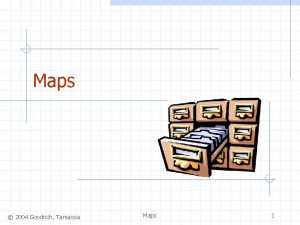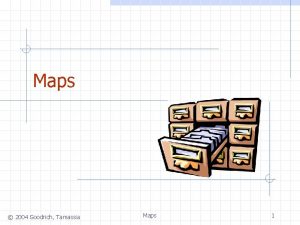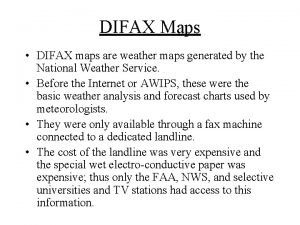NSDS DESIGN PROCESS ROAD MAPS OTHER PRELIMINARIES Prof


















- Slides: 18

NSDS DESIGN PROCESS: ROAD MAPS & OTHER PRELIMINARIES Prof. Ben Kiregyera NSDS Workshop, Addis Ababa, Ethiopia 9 August 2005

I. IMPORTANCE OF THE PROCESS process as important as the Strategy process should be golden opportunity for statistical advocacy especially among political leadership, decision-makers and development partners 2

Purpose of statistical advocacy is to proactively: ü promote “statistical thinking” in society – numeracy (p 23) ü put statistics on the national development agenda (PRS) and make statistics visible ü demonstrate the power and use of statistics ü promote a culture of evidence-based policy and decision-making ü mobilize national & international resources for statistics “Statistics is not just a technical issue, it is a development issue ” Advocacy poorly done in Africa (in general) Why advocacy poorly done ü lack of internalization of the potency of advocacy ü lack of empowerment (limited communication skills) ü lack of advocacy tools (PARIS 21 efforts) 3

taking a cue from PRS process, NSDS process should mainstream key stakeholders i. e should: v be participatory v be inclusive v use a concensus-building approach ü Plans that are country-specific and countryowned ü Ownership leads to more commitment, creativity, imagination, innovation and productivity. Participation and ownership are essential for successful strategic management and the key to the success of strategy “People support what they help to create” 4

process should be empowering Statistical personnel should get exposed to: ü more effective ways of communicating with data users ü international statistical standards, concepts and frameworks ü experiences especially about what is happening in other countries process should broaden and deepen communication ü intra-institutional communication ü inter-institutional communication 5

II. NSDS DESIGN ROAD MAP Preliminary but critical phase of the process During this phase take important decisions on: ü How do we deliver the strategy in efficient manner? Ø who will be main actors? Ø what are timelines? Ø how do we ensure strategy is practical and will be implemented? Ø What will be mechanisms for political support, endorsement and reporting? ü Do we as a country have capacity & skills to undertake the task? Ø If not, what assistance is needed? Ø What form should it take? Ø What will be the source for such assistance? 6

ü How do we ensure that the strategy is relevant to national development objectives? ü How do we ensure that the strategy is country owned? ü What type outputs will be produced and when? Map out the process Ø Set out major stages & processes Ø Political & financial commitments Ø Potential donors 7

Identification and analysis of key stakeholders Aim is to make the NSS stakeholder-driven by identifying the following: Stakeholders: who are they? Need: what is needed from stakeholders for success of the strategy/NSS? Orientation: Impact: what support do you have from them. Are they for you, against you or neutral? what will be the effect of your success on stakeholders? Importance: what is the degree of importance stakeholders have in relation to your ability to achieve your goals? Influence: what is the degree of influence the stakeholders have in relation to your ability to achieve your goals? 8

q Who are stakeholders? Stakeholders are individuals, groups, communities or institution: • affected by impact of an activity, or • can influence an activity. Stakeholders include: • User groups – people who use products in an area • • • Interest groups – people who have an interest in, opinion about, or who can affect the use of, a product/service Beneficiaries of a service Policy & decision-makers 9

Ø Stakeholders • government ministries • public sector institutions e. g. Reserve Bank, parastatals • private sector institutions e. g. Trade Union • civil society institutions e. g. the press, NGOs • research and training institutions e. g. Universities, Research Centres • development partners (donors, international organizations) 10

q stakeholders have different interests & will need different degrees of involvement ü some need to be part of Design Team ü some need to be consulted at different stages ü some will be part of NSDS approval process q for business sector & civil society organization, may use their umbrella organizations as intermediaries e. g. Chamber of Commerce and/or Industry NGO Forum 11

q Stakeholder analysis is a tool for identifying stakeholders and describing the nature of their stake, roles and interests. Stakeholder table Stakeholders Interests Likely impact of NSDS Priority 12

Table showing importance and influence of stakeholders High MONITOR MAXIMIZE COOPERATION IGNORE MONITOR Importance Low Influence High Stakeholder mapping: illustration & analysis of relationship among and between stakeholders 13

NSDS launch workshop Objectives of workshop: • Mainstream stakeholders (participation) in process of designing NSDS • Empowerment of stakeholders • Enhance communication (internal and external) • Engender ownership of process and product (Strategy) Expected outputs • “critical mass” of more informed and empowered stakeholders • greater understanding of problems/constraints/ weaknesses & opportunities in the NSS • broad understanding of the basis for improvement of the NSS • broad consensus on strategies for the development of the NSS 14

Coverage • Undertake comprehensive review the NSS • Introduce relevant management principles and how these can lead to improvement in national statistics • Outline proposals for designing the NSDS & • prepare for implementation including outline of processes and timelines Introduce participants to relevant international concepts, standards, frameworks, guidelines, experiences • Start the process of consultation 15

Workshop organization Check that: § § § key stakeholders invited invitations should go out in good time arrangements made for inviting and briefing Guest of Honour (key policy or decision-maker) § appropriate speech prepared in time Conduct of workshop: q facilitated by consultant q participatory q evaluation END 16

Example of an NSDS roadmap for Zimbabwe END 17

Thank You 18
 Nsds iii
Nsds iii Difference between nsds and hrds
Difference between nsds and hrds Apa itu preliminaries
Apa itu preliminaries Preliminary materials
Preliminary materials Apa itu preliminaries
Apa itu preliminaries Mathematical preliminaries in numerical computing
Mathematical preliminaries in numerical computing Chapter 1 mathematical preliminaries
Chapter 1 mathematical preliminaries Actually synoynm
Actually synoynm Google map reittihaku
Google map reittihaku Paved road vs unpaved road
Paved road vs unpaved road Elevation map mathematical literacy
Elevation map mathematical literacy Mathematical literacy grade 11 assignment topic measurement
Mathematical literacy grade 11 assignment topic measurement Maps plans and other representations of the physical world
Maps plans and other representations of the physical world Elevation map grade 12 maths lit
Elevation map grade 12 maths lit Self-initiated other-repair
Self-initiated other-repair Process design and control design should always be in
Process design and control design should always be in Road design standards
Road design standards Mx road design
Mx road design Is the process of removing food
Is the process of removing food
